Wide q waves in leads ii - Study guides, Class notes & Summaries
Looking for the best study guides, study notes and summaries about Wide q waves in leads ii? On this page you'll find 219 study documents about Wide q waves in leads ii.
All 219 results
Sort by
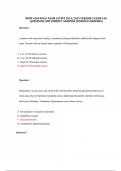 Popular
Popular
-
NRNP 6560 FINAL EXAM LATEST 2024/2025 VERSION 2 EXAM 100 QUESTIONS AND CORRECT ANSWERS (VERIFIED ANSWERS) WALDEN UNIVERSITY
- Exam (elaborations) • 49 pages • 2024
-
 shadow251
shadow251
-
- $15.00
- 1x sold
- + learn more
Question 1 A patient with suspected Cushing’s syndrome is being evaluated to establish the diagnosis and cause. Patients with an adrenal tumor typically will demonstrate: A. Low ACTH and low cortisol B. Low ACTH and high cortisol C. High ACTH and low cortisol D. High ACTH and high cortisol Question 2 Pneumatosis, or gas cysts, may form in the wall anywhere along the gastrointestinal tract; in some cases, they will produce symptoms such as abdominal discomfort, diarrhea with mucus, a...
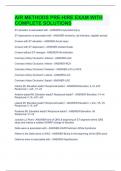
-
AIR METHODS PRE-HIRE EXAM WITH COMPLETE SOLUTIONS
- Exam (elaborations) • 29 pages • 2023
- Available in package deal
-
 Nathan2002
Nathan2002
-
- $14.49
- 13x sold
- + learn more
ST elevation is associated with - ANSWER-myocardial injury ST depressions is associated with - ANSWER-Ischemia, old infarction, digitalis toxicity Q wave with ST elevation - ANSWER-Acute injury Q wave with ST depression - ANSWER-Indeterminate Q wave without ST changes - ANSWER-Old infarction Coronary Artery Occlusion: Anterior - ANSWER-LAD Coronary Artery Occlusion: Inferior - ANSWER-RCA Coronary Artery Occlusion: Posterior - ANSWER-LCX or RCA Coronary Artery Occlusion: L...
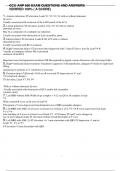
-
GCU ANP 650 EXAM QUESTIONS AND ANSWERS VERIFIED 100% ( A SCORE)
- Exam (elaborations) • 11 pages • 2023
-
 Academicmines
Academicmines
-
- $12.99
- 2x sold
- + learn more
1. Anterior infarction: ST elevation, Leads V1, V2, V3, V4 with or without abnormal Q waves Usually associated with occlusion of the LAD branch of the LCA 2. Lateral infarction: ST elevation, Leads I, aVL, V5, V6 with or without abnormal Q waves May be a component of a multiple site infarction Usually associated with obstruction of Left circumflex artery 3. Inferior infarct: ST elevation, Leads II, III, aVF with or without abnormal Q wave Usually associated with RCA occlusion 4. Right Ven...
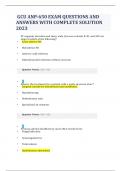
-
GCU ANP-650 EXAM QUESTIONS AND ANSWERS WITH COMPLETE SOLUTION 2023
- Exam (elaborations) • 29 pages • 2023
-
 Academicmines
Academicmines
-
- $12.99
- 2x sold
- + learn more
GCU ANP-650 EXAM QUESTIONS AND ANSWERS WITH COMPLETE SOLUTION 2023 ST-segment elevation and deep, wide Q waves in leads II, III, and aVF are a sign of which of the following? • Acute inferior MI • Old inferior MI • Anterior wall ischemia • Subendocardial ischemia without necrosis • What is the treatment for a patient with a septic pressure ulcer? • Surgical consult for debridement and antibiotics • Hydrotherapy • Debridement only • Specialized a...
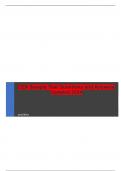
-
CEN Sample Test Questions and Answers Updated 2024
- Exam (elaborations) • 28 pages • 2024
- Available in package deal
-
 PossibleA
PossibleA
-
- $15.49
- + learn more
Right ventricular infarction (RVI) lead changes - II, III, AVF R ventricular infarction s/s - clear breath sounds, hypotension, JVD. R ventricular dilation and dec contractility>> dec preload and CO Reperfusion therapy standard - Within 60 min of ED arrival Common causes of PEA - Hypoxia, tension pneumo, cardiac tamponade BNP as a marker - of L ventricular dysfunction bc ventricles make BNP and an inc of over 100 pg/ml indicates symptomatic HF Transcutaneous pacing (TCP) - ...
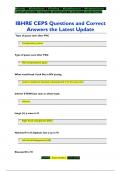
-
IBHRE CEPS Questions and Correct Answers the Latest Update
- Exam (elaborations) • 151 pages • 2024
- Available in package deal
-
 TestTrackers
TestTrackers
-
- $16.49
- + learn more
Type of pause seen after PVC Compensatory pause Type of pause seen after PAC Non-compensatory pause What would lead I look like in BiV pacing small or isoelectric because activating both V at the same time Inferior STEMI best seen in which leads inferiors Large (+) p wave in II Right Atrial enlargement (RAE) Notched P in II; biphasic late (-) p in V1 Left Atrial Enlargement (LAE) Elevated R in V1 #Examify | #OnlineExams | #TestPrep | #StudyResources | #AcademicSuccess | #Exa...
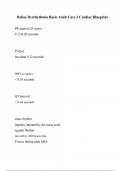
-
Relias Dysrhythmia Basic Adult Care 3 Cardiac Blueprint
- Exam (elaborations) • 46 pages • 2025
-
 boomamor2
boomamor2
-
- $12.00
- + learn more
PR interval (P wave) 0.12-0.20 seconds P wave less than 0.12 seconds QRS complex < 0.10 seconds QT interval < 0.44 seconds sinus rhythm impulse initiated by the sinus node regular rhythm rate 60 to 100 beats/min P wave before each QRS Normal PR, QRS, and QT interval PR interval "0.12 to 0.20 seconds and constant QRS duration: 0.04 to 0.10 seconds sinus tachycardia sinus rhythm with a rate of 100 to 150 beats/min normal P wave P wave before every QRS assess for sympto...
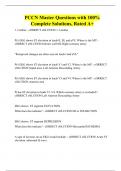
-
PCCN Master Questions with 100% Complete Solutions, Rated A+
- Exam (elaborations) • 40 pages • 2024
-
 TeeGrades
TeeGrades
-
- $13.99
- + learn more
1. Cardiac - cORRECT sOLUTION 1. Cardiac Pt's EKG shows ST elevation in leads II, III, and aVF. Where is the MI? - cORRECT sOLUTION Inferior wall MI, Right coronary artery "Reciprocal changes are often seen ini leads I and aVL" Pt's EKG shows ST elevation in leads V1 and V2. Where is the MI? - cORRECT sOLUTION Septal area, Left Anterior Descending Artery Pt's EKG shows ST elevation in leads V3 and V4. Where is the MI? - cORRECT sOLUTION Anterior area Pt has ST elevation in le...
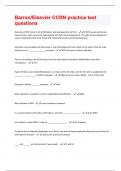
-
Barron/Elsevier CCRN practice test Questions and Answers well Explained Latest 2024/2025 Update 100% Correct.
- Exam (elaborations) • 29 pages • 2024
- Available in package deal
-
 ACADEMICMATERIALS
ACADEMICMATERIALS
-
- $7.99
- + learn more
How does COPD result in atrial fibrillation and predisposition to PEs? - COPD causes pulmonary hypertension, right ventricular hypertrophy, and right atrial enlargement. The right atrial enlargement causes stretching of the atrial tissue and frequently results in atrial dysrhythmias. SA blocks, second-degree AV block type I, and third-degree AV heart block at the level of the AV node would occur in _______________ occlusion - RCA (as seen in inferior wall MIs) There is (more/less) risk of b...
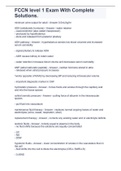
-
FCCN level 1 Exam With Complete Solutions.
- Exam (elaborations) • 13 pages • 2022
-
 EvaTee
EvaTee
-
- $13.99
- 6x sold
- + learn more
minimum urine output for adult 0.5mL/kg/hr ADH (antidiuretic hormone) - water retainer - vasoconstrictor (also called Vasopressin) - produced by hypothalamus - store and released from posterior pituitary ADH pathway - hypothalamus senses low blood volumed and increased serum osmolality - signal pituitary to release ADH - ADH causes kidney to retain water - water retention increases blood volume and decreases serum osmolality ANP (atrial natriuretic peptide) -...

$6.50 for your textbook summary multiplied by 100 fellow students... Do the math: that's a lot of money! Don't be a thief of your own wallet and start uploading yours now. Discover all about earning on Stuvia


